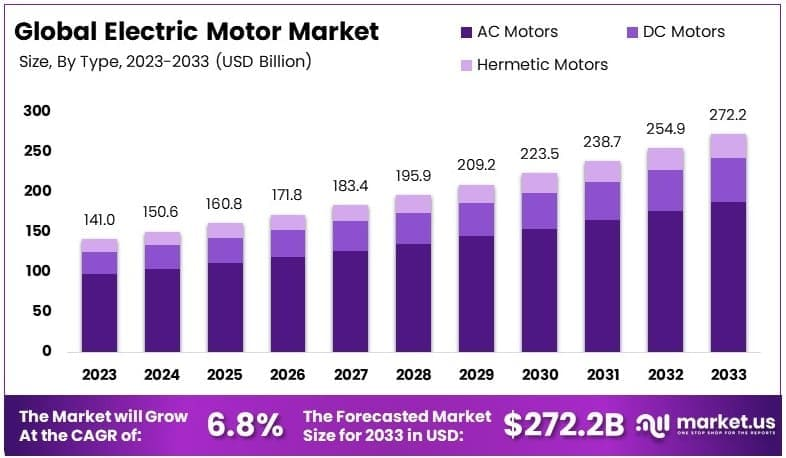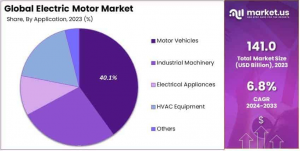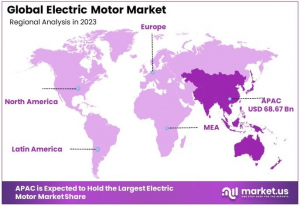
Electric Motor Market to Expand at 6.8% CAGR, Reaching USD 272.2 Billion by 2033

Electric Motor Market By Size
The Electric Motor Market size is expected to be worth around USD 272.2 Bn by 2033, from USD 141.0 Bn in 2023, growing at a CAGR of 6.8% during forecast period.
NEW YORK, NY, UNITED STATES, January 22, 2025 /EINPresswire.com/ -- Report Overview
According to the report by Market.us, the global Electric Motor Market was valued at USD 141.0 Billion in 2023 and is expected to reach USD 272.2 Billion by 2033, growing at a compound annual growth rate (CAGR) of 6.8% from 2024 to 2033.
This rapid growth reflects the increased demand for electric motors across various industries, driven largely by advancements in the automotive sector, including the surge in electric vehicle (EV) production, and the rising need for energy-efficient industrial solutions. The electric motor, a device that converts electrical energy into mechanical energy through electromagnetic fields, plays a critical role in industries like manufacturing, transportation, and household appliances.
The electric motor market is segmented by type, power output, and application, with significant variations across regions. The demand for AC motors, which dominate the type segment, is largely driven by their efficiency and applicability in industrial settings. Fractional horsepower motors lead the power output segment, widely used in household appliances and machinery.
Want Deeper Insights? Explore Our Report Samples and Take Action Today - https://market.us/report/electric-motor-market/request-sample/
Key Takeaways
~ The Electric Motor Market was valued at USD 141.0 Billion in 2023, with projections to grow to USD 272.2 Billion by 2033, at a CAGR of 6.8%.
~ AC Motors hold the largest share in the motor type segment, accounting for 69.1% of the market.
~ Fractional Horsepower motors dominate the power output segment with an 84% market share due to their efficiency and low cost.
~ The motor vehicle application leads with 40.1% of the market share, primarily driven by the rise of electric vehicle adoption.
~ APAC is the largest regional market, contributing to 48.7% of the global share, largely driven by manufacturing, electric vehicle production, and renewable energy initiatives.
Regional Analysis
The Asia Pacific (APAC) region leads the Electric Motor Market with a 48.7% share in 2023, valued at USD 68.67 billion. This dominance is driven by rapid industrialization, increasing urbanization, and significant investments in manufacturing and infrastructure. Major economies like China, India, and Japan are key contributors to the region's growth, supported by strong automotive, electronics, and renewable energy sectors. As electric vehicles gain momentum and industries adopt automation solutions, the demand for electric motors continues to rise. Government policies promoting sustainable development and technological innovations further boost market growth in APAC. The region’s influence is expected to continue growing, especially with initiatives focused on electric mobility, renewable energy, and industrial automation.
Report Segmentation
By Type
The Electric Motor Market is segmented by motor type into AC Motors, DC Motors, and Hermetic Motors. AC Motors dominate the market, holding a 69.1%
share in 2023. This widespread adoption is due to the motors' efficiency, versatility, and lower maintenance requirements, especially in industrial and commercial applications. DC Motors, while occupying a smaller portion of the market, are crucial in applications requiring precise speed control and high torque, such as in electric vehicles. Hermetic Motors are primarily used in refrigeration and HVAC systems due to their sealed design, making them ideal for harsh environments.
By Power Output
The market is also segmented by power output into Integral Horsepower (Above 1HP) and Fractional Horsepower (Up to 1HP). Fractional Horsepower motors hold a dominant 84% of the market due to their efficiency and suitability for lower power applications such as household appliances, small machinery, and HVAC systems. Integral Horsepower motors are essential for heavy-duty industrial applications requiring higher power and reliability, though they occupy a smaller market share.
By Application
In terms of application, the Electric Motor Market is divided into Motor Vehicles, Industrial Machinery, Electrical Appliances, HVAC Equipment, and Others. The automotive sector, specifically the electric vehicle market, is the largest application segment, accounting for 40.1% of the market in 2023. Other significant applications include industrial machinery, electrical appliances, and HVAC systems, all of which rely heavily on energy-efficient electric motors to drive performance.
Key Market Segments
By Type
~ DC Motors
~ AC Motors
~ Hermetic Motors
By Power Output
~ Integral Horsepower (Above 1HP)
~ Fractional Horsepower (Up to 1HP)
By Application
~ Motor Vehicles
~ Industrial Machinery
~ Electrical Appliances
~ HVAC Equipment
~ Others
Purchase the Complete Report Now with up to 30% off at https://market.us/purchase-report/?report_id=51758
Driving Factors
The electric motor market is propelled by several driving factors that include the growing emphasis on energy efficiency and environmental sustainability. As industries across the globe strive to reduce carbon footprints, the demand for energy-efficient electric motors rises. Government regulations and incentives further accelerate this trend by encouraging investment in green technologies. Increased automation in manufacturing sectors and a surge in the use of electric vehicles boost the need for sophisticated electric motors. The integration of Internet of Things (IoT) technologies into electric motor systems enhances performance and predictive maintenance capabilities, attracting investments. Advancements in design and manufacturing processes, such as the use of rare-earth magnets and improved thermal management, reduce operational costs and increase motor lifespan. Overall, these factors create a robust market environment that supports growth, innovation, and adoption of electric motors in various applications, from industrial machinery to consumer electronics, ensuring steady market expansion.
Restraining Factors
Despite growth prospects, the electric motor market faces several restraining factors that could hinder its progress. High initial costs associated with advanced technologies and the price volatility of raw materials, such as rare-earth elements, present significant barriers. Additionally, market penetration challenges exist in regions lacking infrastructure for the adoption of electric motors, particularly in developing countries. The complexity of integrating new motor technologies with existing systems requires specialized skills and knowledge, limiting wider acceptance. Moreover, competition from traditional combustion engines and reluctance of industries to shift due to concerns over reliability and maintenance costs slow down the transition. Supply chain disruptions, influenced by geopolitical tensions and economic uncertainties, also create volatility. Environmental regulations, while promoting greener solutions, often impose stringent standards that increase compliance costs. These factors combined may impede the swift adoption and scaling of electric motor technologies.
Trending Factors
The electric motor market is witnessing several trending factors that signal a shift toward more advanced and efficient systems. One notable trend is the increasing adoption of smart electric motors integrated with IoT capabilities, enabling real-time monitoring and predictive maintenance, which reduces downtime and enhances efficiency. Advances in materials science and manufacturing techniques are leading to lighter, more powerful motors with reduced energy consumption. There is also a trend towards customization, where motors are tailored for specific industrial applications, driving innovation. The market sees a growing focus on miniaturization and the development of compact motors suitable for consumer electronics and aerospace. Additionally, sustainability trends push manufacturers to develop motors with recyclable components and environmentally friendly production processes. These trends are supported by increasing research and development investments and partnerships between technology firms and traditional motor manufacturers, fostering a collaborative ecosystem that accelerates technological breakthroughs.
Investment Opportunities
Investment opportunities in the electric motor market are abundant due to the ongoing transformation across various industries. Venture capitalists and institutional investors are eyeing startups that offer innovative motor designs, especially those utilizing advanced materials and IoT integration. There is significant potential in funding research and development projects focused on increasing energy efficiency, reducing costs, and improving motor performance. Investments in manufacturing automation and smart factory setups can streamline production, reduce waste, and enhance quality. Expanding the supply chain for critical components like rare-earth magnets presents another lucrative avenue, as does partnering with companies specializing in electric vehicle components. Governments and private sectors alike show interest in sustainable projects, providing subsidies and grants that make investments more attractive. Moreover, opportunities in emerging markets to modernize infrastructure and adopt electric solutions present high growth potential. Strategic mergers and acquisitions can also consolidate expertise, expand market reach, and accelerate innovation in this rapidly evolving sector.
Market Companies
The global Electric Motor Market is highly competitive, with key players investing heavily in R&D, strategic partnerships, and expanding their product portfolios. Companies such as ABB, Siemens, Nidec, and Johnson Electric are leading the market with advanced technological offerings in various motor types and applications. These companies are focusing on energy-efficient solutions, automation integration, and developing smart electric motors to meet the demands of industries such as automotive, manufacturing, and renewable energy. Additionally, regional players and emerging companies are gaining traction by offering specialized motor solutions and capitalizing on opportunities in emerging markets.
Key Players
~ ABB
~ Siemens
~ Johnson Electric
~ Nidec Motor Corporation
~ Rockwell Automation
~ General Electric
~ WEG
~ Toshiba Corporation
~ Hitachi
~ Mitsubishi Heavy Industries
~ TECO-Westinghouse Motor Company
~ Arc Systems Inc.
~ DENSO
~ Regal Beloit Corporation
Conclusion
The electric motor market is witnessing robust growth driven by increasing adoption in industrial automation, electric vehicles (EVs), and renewable energy systems. Demand for energy-efficient motors and government regulations promoting sustainability are key growth drivers. Technological advancements and the transition to smart and connected motors further enhance market potential. Companies focusing on innovation and sustainability will capitalize on growing opportunities.
Lawrence John
Prudour
+91 91308 55334
email us here
Visit us on social media:
LinkedIn
Distribution channels: Manufacturing
Legal Disclaimer:
EIN Presswire provides this news content "as is" without warranty of any kind. We do not accept any responsibility or liability for the accuracy, content, images, videos, licenses, completeness, legality, or reliability of the information contained in this article. If you have any complaints or copyright issues related to this article, kindly contact the author above.
Submit your press release

